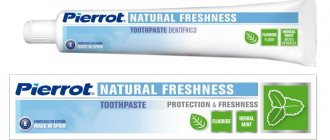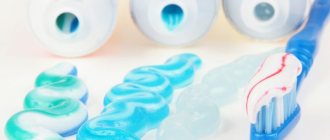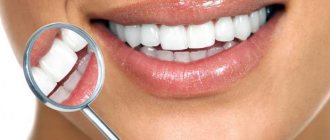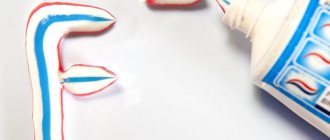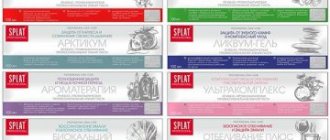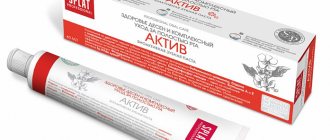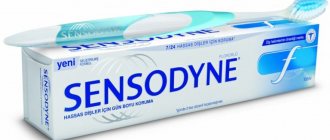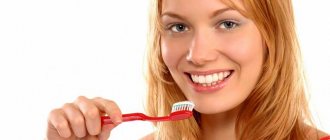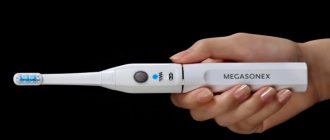Toothpaste is an important element of comprehensive hygiene. It allows you not only to clean your teeth and braces from plaque, but is also an excellent means of preventing many dental diseases - after all, in the presence of braces, the risk of developing caries, gum inflammation, darkening and pigmentation of tooth enamel significantly increases.
Active components
All toothpastes are divided into two main types: therapeutic and preventive. They differ in the presence of active substances or components. Let's consider which pastes are suitable for use in the presence of installed braces.
- with fluoride: effective protection of teeth from caries, strengthening and saturation of enamel,
- with calcium: restores and strengthens tooth enamel, fights caries,
- with low content of abrasive particles and potassium: reduces tooth sensitivity,
- with herbal ingredients: reduce inflammation and bleeding of gums,
- with a large number of abrasive particles: whitening pastes that allow you to remove pigmented plaque from the enamel.
There are orthodontic pastes that are specially designed to protect teeth while wearing braces. They simultaneously cope with many problems: reduce the sensitivity of enamel, strengthen it, stimulate the restoration and healing of soft tissues, and freshen breath.
Problems that may arise while wearing braces
Modern braces allow you to almost perfectly straighten your teeth and correct your bite, making your smile more correct and beautiful. But the main disadvantage of these designs is that they significantly complicate the process of cleaning teeth. Food debris and dental plaque accumulate under the elements of the corrective structure, leading to the following undesirable consequences:
- high risk of proliferation and accumulation of bacteria;
- the appearance of bad breath;
- caries development;
- formation of tartar.
In addition, after eating, where the structural elements fit tightly to the teeth, organic acids destroy the enamel more strongly than in the free areas of the dentition. In places where braces come into contact with the mucous membrane and gums, irritation or inflammatory reactions may occur.
Correctly selected toothpaste will help to avoid such problems, which will ensure high-quality cleansing of the oral cavity, strengthen the enamel and prevent the occurrence of inflammatory processes.
Selection rules
The issue of choosing toothpaste must be approached very carefully: most likely, the product that you used before installing braces will not work. After all, during orthodontic treatment, more plaque accumulates, pigmentation occurs on the teeth, the enamel becomes more sensitive, and problems with the gums may even appear that were not there before. You will have to select a remedy that will cope with the problems that arise.
Together with your doctor, you need to select a set of different toothpastes - they need to be alternated periodically, depending on the condition of your teeth and gums.
- in the first 2-3 weeks after installing braces, you should avoid using pastes containing fluoride: this microelement is often contained in the adhesive composition, so an excess of it may occur,
- You should not use whitening pastes: they will change the shade of the enamel everywhere except where the braces are fixed. After removing the plates, the teeth will have areas of different colors; a whitening procedure will have to be carried out (and this is not always possible immediately due to the increased sensitivity of the enamel),
- most often it is worth using toothpastes for sensitive teeth: after installing braces, patients very often complain of pain that occurs when inhaling cold air, brushing their teeth, or even while eating. This is nothing more than increased sensitivity - the enamel can be strengthened by using a product with a low content of abrasive particles,
- emphasis on pastes with enzymes: they help break down plaque that has accumulated in hard-to-reach places.
Choosing the right product will help reduce the stress on your teeth and gums while wearing braces. It is important to closely monitor the condition of your teeth and quickly respond to changes by changing the type of toothpaste. Consultations with your doctor throughout the entire treatment period will help you choose the most effective dental care products.
Basic rules for caring for teeth with braces
As mentioned above, proper care of the braces system begins with brushing your teeth. Using circular movements, it is necessary to clean each tooth from the outside and back. When using an electric toothbrush, it is strictly forbidden to press the head too hard against metal elements. This risks causing the bristles to break out and get stuck in the ligatures.
Next, you need to use a floss toothpick or a special brush to remove plaque from the interdental spaces. But to remove food debris directly from under the braces, waxed dental floss is suitable. To clean, you need to tear off about 30 centimeters of thread and carefully insert it under the staple. Then pull the thread under the rings and holes in the locks and make several cleaning movements. Repeat the procedure with each tooth. Next, you can begin to carry out the above-described care program directly for braces, after rinsing your mouth with salt water or a special solution.
Cost of toothpaste for braces
You can purchase the product at any store or pharmacy. Below we will give some examples of the most popular and effective dental care products that have high ratings.
| Name | Price |
| Parodontax against gum disease | from 140 rubles |
| Splat medicinal herbs against gum inflammation | from 120 rubles |
| Lacalut Sensitive for sensitive teeth | from 220 rubles |
| Lacalut Aktiv to treat gum inflammation and protect teeth from caries | from 140 rubles |
| PresiDENT Classic for caries prevention | from 130 rubles |
| Colgate Elmex for caries prevention | from 230 rubles |
| Orthodontic toothpaste Pierrot Natural Freshness | from 300 rubles |
| Gel for strengthening teeth ROCS | from 400 rubles |
| Gel for strengthening teeth ROCS for children and adolescents | from 400 rubles |
Antibacterial pastes
If for some reason toothpaste for every day is not enough (for example, due to inflammation of the mucous membrane or too rapid plaque formation), you should choose a toothpaste with a strong antibacterial effect. Pastes with chlorhexidine work best, but they can only be used as a course.
Elgidium Anti-plaque toothpaste with chlorhexidine
Toothpaste CURAPROX PerioPlus SUPPORT chx 0.09%
Dentaid Perio-Aid toothpaste with chlorhexidine 0.12%
Toothpaste Montcarotte RAPID15 Red grapefruit
You can choose a toothpaste to suit any budget - in our selection there are options from 300 to 1400 rubles. Remember that brushing technique is very important to achieve the best results - consult your orthodontist about this. In addition, the duration of brushing teeth with braces increases to 5 minutes.
Patient reviews
“I had to change my toothpaste constantly - I got braces while I was breastfeeding my baby, so my teeth just started to crumble. Constantly a large amount of vitamins, strengthening pastes, against gum inflammation. I have a whole arsenal at home! But it’s okay, I dealt with the problem and didn’t lose my teeth))) My gums also gradually returned to normal. Of course, I had to wait until I finished feeding, but I really couldn’t wait to get the results! I advise everyone not to ignore cleaning!!! It will keep your teeth healthy and white.”
Irene, from correspondence from forums
“I tried several pastes, but in the end I settled on one special one. I really liked the orthodontic one - it copes really well with plaque and has a comprehensive effect on both teeth and gums. I wore braces for 2.5 years and used a specialized paste for about two years; after removing the braces, there was no pigmentation, which made me very happy.”
Maria, 29 years old, Syktyvkar
What braces care products do orthodontists recommend using?
As for toothpaste, it is better to give preference to one that contains fluoride and xylitol. You can also choose a mouthwash with a similar composition. Fluoride will help prevent tooth decay, and xylitol will protect against bacteria and germs. Also, xylitol-based products leave a pleasant feeling of coolness, which allows you to forget about the presence of iron braces in your mouth for a while.
As for home remedies, dentists recommend using plain salt water as a rinse. Rapa will quickly relieve pain, which often occurs in the first month after installation of the system, and will also destroy bacteria in the oral cavity. Salt water will help heal sores and cuts that may appear on the gums or the mucous membranes on the inside of the cheek. To prevent damage to mucous membranes, it is better to use professional braces care products.
Is periodic replacement required?
Unfortunately, our body tends to get used to the constantly used composition. As a result, the degree of exposure to paste components is significantly reduced. Therefore, the orthodontic hygiene product should be changed periodically.
For example, you can use a calcium-rich formula for several months to strengthen your enamel. Then replace the product with a fluoride toothpaste to prevent tooth decay. Next, you can pay attention to anti-inflammatory compounds.
Before purchasing a paste, it is advisable to consult with a specialist who will assess the condition of the oral cavity and recommend which composition is best to start with.
Systems and whitening preparations
Experts strongly recommend excluding lightening pastes during treatment.
This is explained by the fact that after removing the structure, the areas of enamel to which its elements were attached will stand out significantly.
Such a defect cannot always be corrected even in the dental chair.
Causes of dental crowding and ways to eliminate pathology.
In this publication we will talk about the procedure for performing orthognathic surgery.
At this address https://orto-info.ru/ortodonticheskoe-lechenie/osnovnoy-period/kak-snimayut-breketyi.html we offer to learn how braces are removed.
Special Additives
These types of enzymes help patients who cannot clean their teeth for the right time and quality. Such patients include those wearing braces and small children. The content of special additives in the cleaning composition helps to soften, foam, and then remove plaque. They clean teeth even in hard-to-reach places.
Whitening elements are represented by peroxides that enter into a slight chemical reaction with the surface of the teeth. The treated area becomes lighter. For patients wearing braces, toothpaste with whitening compounds is not recommended. After all, parts of the teeth covered with braces will not be whitened, and after removing the leveling systems, the smile will look very unattractive.
The patient may or may not like the toothpaste. Flavors and flavorings are quite important for humans. They use artificial and natural (menthol, carvacrol) components.
Rules of application
To effectively combat bacterial plaque, a special paste composition alone is not enough. You still need to master the cleaning technique.
There are no special rules for using orthodontic paste. The product, as when cleaning enamel with the usual composition, is squeezed onto the brush in an identical amount. The technique of brush movements and the duration of the procedure play a big role.
It is necessary to pay attention to each tooth to which the structure is adjacent, and especially to the area of contact between braces and enamel. For this purpose, modern dentistry suggests using brushes, monotuft brushes, and irrigators.
The duration of the procedure should not be less than 5 minutes, otherwise the beneficial components of the composition will not have time to fully manifest themselves.
Nutritional Features
Do not be alarmed - a person will not be required to strictly adhere to a diet, but dietary adjustments are still necessary. Wearing braces imposes some restrictions on food intake, and for their safety and dental health, it is better to follow all the doctor’s recommendations. It is advisable to avoid consuming the following foods:
- Sticky and viscous confectionery products: chewing gum, chewing candies, toffees and other products that stick strongly to the teeth. Sticky foods can lead to tooth decay and other dental diseases.
- Solid foods. These include sweets, crackers, nuts, as well as hard fruits and vegetables: apples, carrots - all those that need to be bitten. Hard ones can cause serious damage to tooth enamel, as well as displace the structure and lead to its improper functioning. In addition, detachment of the structure may occur, which will require dental intervention.
- Coloring food that contains a large amount of dyes of natural or artificial origin.
- Hot or cold foods. Sudden temperature changes have a particularly negative effect: for example, drinking cold ice cream after hot coffee. It is recommended to refrain from eating too hot or cold food, limiting yourself to eating warm dishes.
